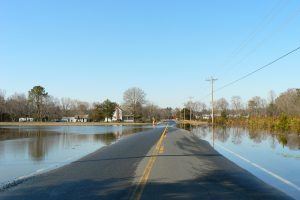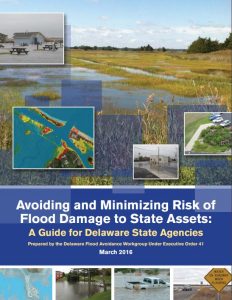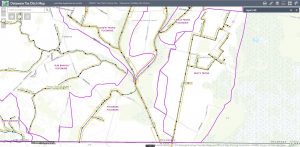
Delaware is a coastal state. Most of the land in Delaware is flat and close to sea-level. Our underlying water table is generally high. As a result, drainage and the management of stormwater are important considerations in land use planning, construction, and agriculture.
The Department of Natural Resources and Environmental Control (DNREC) works with other state agencies, with county and municipal governments, and with partners in the private sector to ensure that Delawareans are safe from flooding events, and that water draining from the land is properly controlled and filtered to remove pollutants. DNREC oversees drainage, control of sediment and stormwater, management of tax ditches, and the safety of the state’s dams.
 Wet weather and storms — northeasters, hurricanes, or heavy rains — all carry risks of different types of flooding in Delaware. Parts of the coast are subject to coastal flooding related to storm surge. Low-lying areas can become inundated when several tides back-up during coastal storms. When rainy weather lasts long enough, the ground can become saturated and lose its ability to absorb rainwater. The DNREC Floodplain Management program studies flood risk and works with federal agencies, as well as local governments to mitigate flooding problems. Some flood-related resources:
Wet weather and storms — northeasters, hurricanes, or heavy rains — all carry risks of different types of flooding in Delaware. Parts of the coast are subject to coastal flooding related to storm surge. Low-lying areas can become inundated when several tides back-up during coastal storms. When rainy weather lasts long enough, the ground can become saturated and lose its ability to absorb rainwater. The DNREC Floodplain Management program studies flood risk and works with federal agencies, as well as local governments to mitigate flooding problems. Some flood-related resources:
The Delaware Flood Planning Tool offers an online map to help research flood risk for different properties in Delaware
An interactive Sea Level Rise Inundation Map offers guidance on areas that might be subject to flooding under different sea level rise forecasts
DNREC offers a Drainage and Stormwater Assistance hotline at 302-855-1955 or by e-mail at dnrec_drainage@delaware.gov
The Cabinet Committee on Climate and Resiliency’s guide for Avoiding and Minimizing Risk of Flood Damage to State Assets
Information about Delaware’s plans to adapt to changes in sea levels
Information about Delaware’s Dam Safety program
 “Tax Ditch” is a general term used to describe both a system of engineered ditches used to manage stormwater and drainage for a specific area and the political subdivision of state government by which each system of ditches is governed. Delaware tax ditches are established under Delaware state law (7 Del. Code, Chapter 41). Each of Delaware’s more than 230 Tax Ditches is overseen by a board of Tax Ditch Managers selected from among the landowners of the lands to be drained by the ditch system.
“Tax Ditch” is a general term used to describe both a system of engineered ditches used to manage stormwater and drainage for a specific area and the political subdivision of state government by which each system of ditches is governed. Delaware tax ditches are established under Delaware state law (7 Del. Code, Chapter 41). Each of Delaware’s more than 230 Tax Ditches is overseen by a board of Tax Ditch Managers selected from among the landowners of the lands to be drained by the ditch system.
View an interactive online map of Delaware’s Tax Ditches
Use an online map tool to check if a Delaware property is part of a Tax Ditch
See how Tax Ditch managers are working with wetland scientists and engineers to add to the state’s wetland resources and help improve ditches through wetland and channel restoration
It is Delaware landowners who ultimately will make the greatest difference in controlling flooding and managing stormwater and sediments. To help guide their efforts, the Division of Watershed Stewardship provides technical assistance and training, and oversees regulations related to sediment and stormwater, under the Erosion and Sedimentation Control Act (7 Del. Code, Chapter 40).
Detailed technical documents, guidelines and other resources provide policies, procedures, checklists and examples to assist the regulated community in complying with the sediment and stormwater regulations, specifically the Delaware Erosion and Sediment Control Handbook and Post Construction Stormwater BMP Standards and Specifications.
DNREC offers two certification courses for those involved in construction:
- Contractor’s Certification, also known as “Blue Card Certification,” for those responsible for daily oversight of construction activities
- A Certified Construction Reviewer course for private inspectors
And DNREC offers Designer Training for individuals who will be preparing plans and engineering computations
DNREC oversees the National Pollutant Discharge Elimination System (NPDES) for stormwater runoff, which requires submission of a Notice of Intent (NOI) for stormwater discharges associated with construction activities
DNREC publishes a full listing of NOIs submitted for construction activities
Industrial sites are required to obtain permit coverage to discharge stormwater
DNREC works closely with three county-level Conservation Districts to help implement agricultural and urban/suburban conservation programs, provide technical assistance to landowners,and to provide regulatory review of sediment and stormwater activities. The Districts are established in Delaware state law (7 Del. Code, Chapter 39) and interface with DNREC through the Conservation Programs Section.
The New Castle Conservation District: 302-832-3100 or ncastle@newcastleconservationdistrict.org
The Kent Conservation District: 302-761-2600 or questions@kentcd.org
The Sussex Conservation District: 302-856-2105
For general information about watersheds in Delaware and oversight of conservation, drainage and stormwater programs, contact the Division of Watershed Stewardship: 302-739-9921
For information on flood mitigation, drainage, tax ditches, and assistance for landowners, contact the Drainage Program: 302-855-1930
For information on controlling sediment and stormwater, contact the Sediment and Stormwater Program: 302-739-9921
For information on sea level rise and coastal flooding threats, contact the Delaware Coastal Management Program: 302-739-9283
Related Topics: coast, drainage, ocean, sea level rise, stormwater, topic